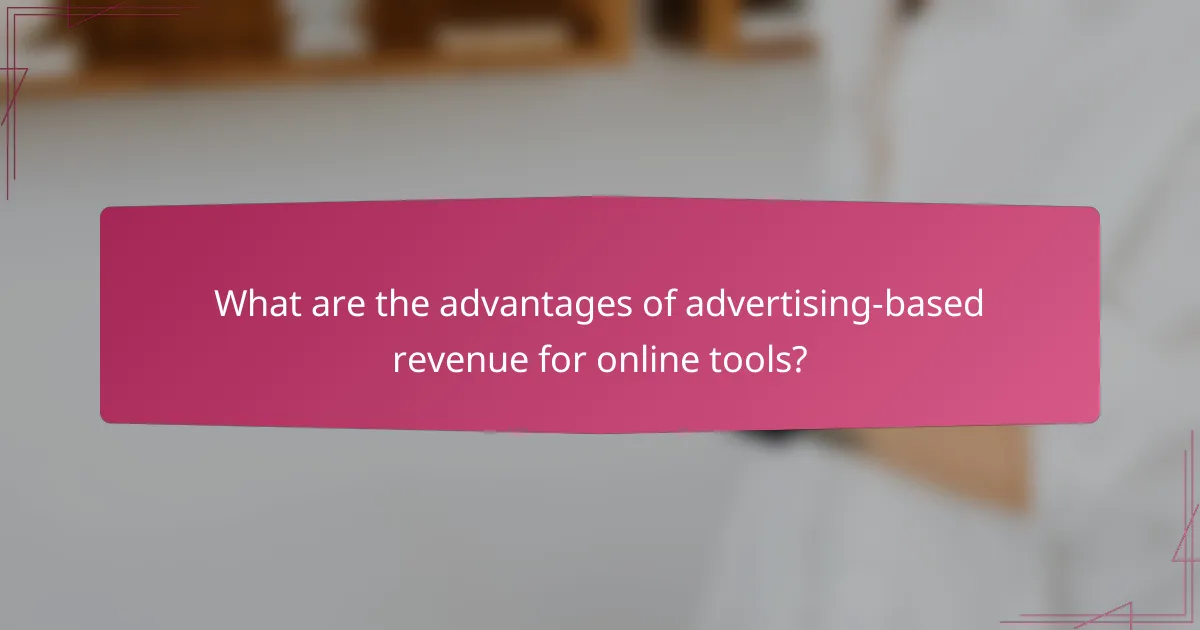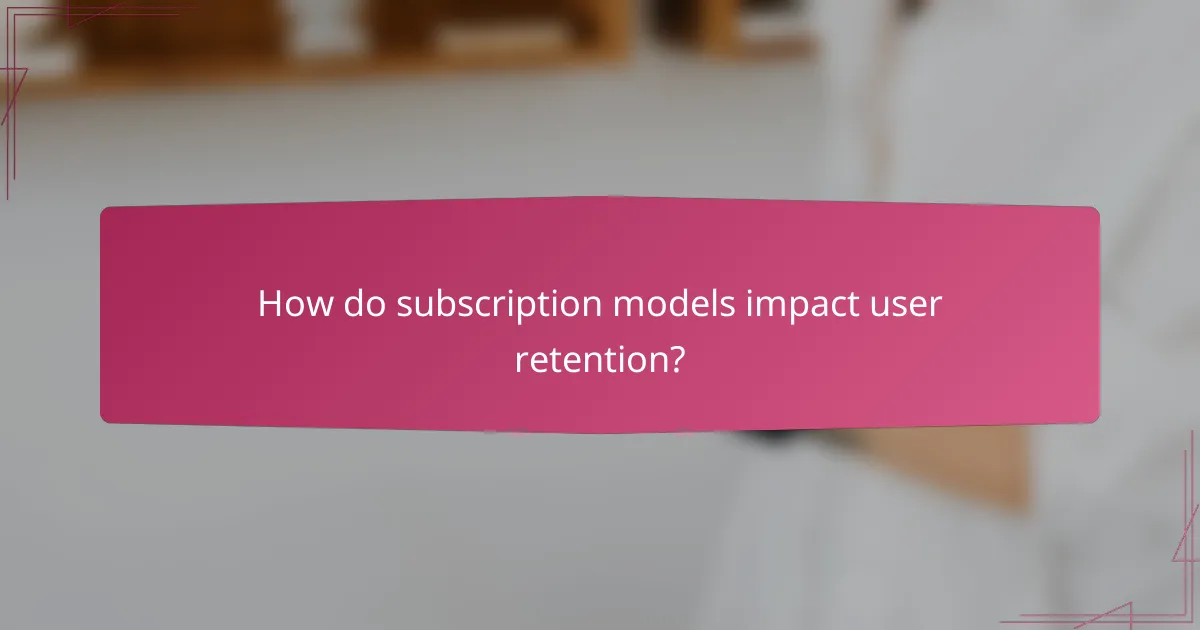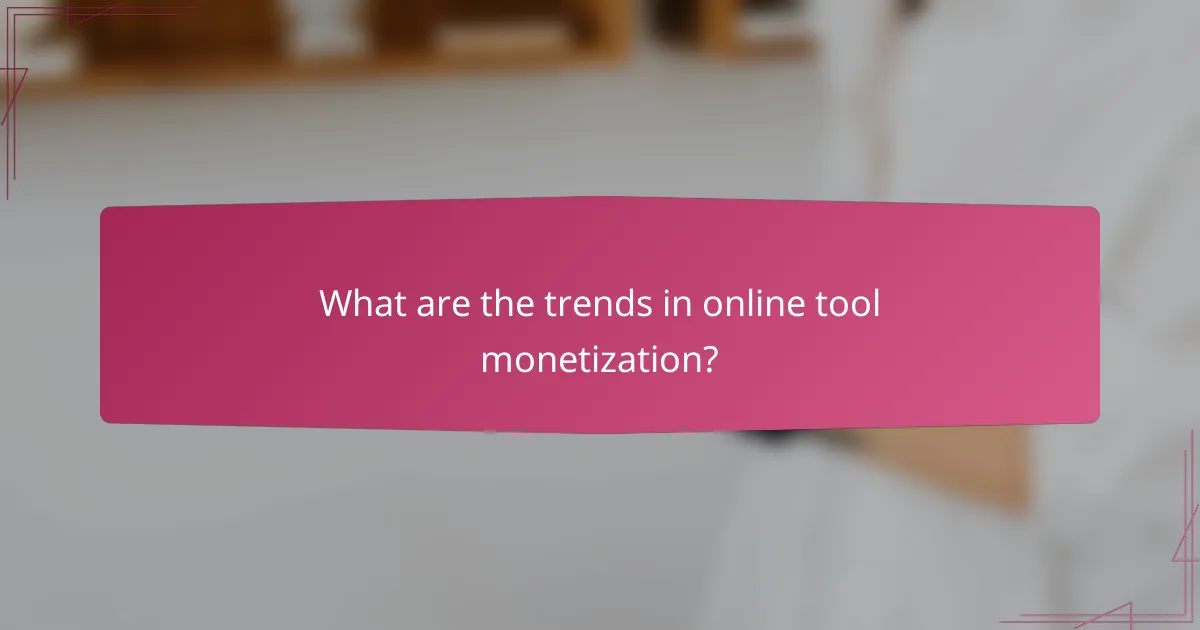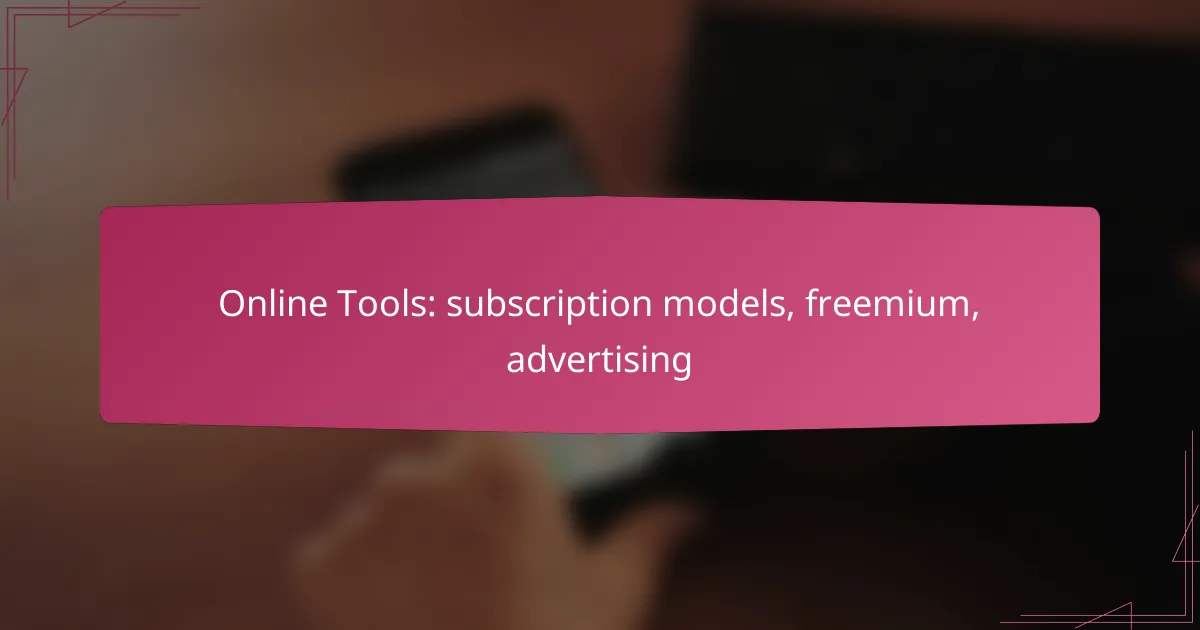Online tools often utilize various subscription models to cater to diverse user needs and business objectives, including monthly, annual, and tiered pricing options. The freemium model is particularly popular, allowing users to access basic features for free while offering premium upgrades for a fee. Additionally, advertising-based revenue enables these tools to provide low-cost or free access, generating income through ads and appealing to a broader audience.

What are the best subscription models for online tools?
The best subscription models for online tools vary based on user needs and business goals. Common models include monthly, annual, tiered pricing, pay-as-you-go, and enterprise licensing, each offering distinct advantages and considerations.
Monthly subscription
A monthly subscription model allows users to pay a set fee each month for access to an online tool. This model is attractive for users who prefer flexibility and want to avoid long-term commitments.
However, while monthly payments can be easier to manage, they may result in higher overall costs compared to annual subscriptions. Businesses should consider offering discounts for longer commitments to encourage user retention.
Annual subscription
Annual subscriptions require users to pay for a full year upfront, often at a discounted rate compared to monthly payments. This model is beneficial for both users and providers, as it ensures a steady revenue stream and encourages long-term usage.
Companies should clearly communicate the savings associated with annual plans to attract subscribers. It’s also wise to offer a money-back guarantee to reduce perceived risk for new users.
Tiered pricing
Tiered pricing involves offering multiple subscription levels with varying features and price points. This model caters to different user needs, allowing individuals and businesses to select a plan that best fits their requirements.
When implementing tiered pricing, it’s crucial to clearly outline the differences between each tier. This transparency helps users make informed decisions and can lead to upselling opportunities as their needs grow.
Pay-as-you-go
The pay-as-you-go model charges users based on their actual usage of the tool, making it ideal for those who may not need consistent access. This model can attract users who are hesitant to commit to a subscription.
However, businesses should ensure that pricing is straightforward and that users can easily track their usage to avoid unexpected charges. Providing clear usage metrics can enhance user satisfaction and trust.
Enterprise licensing
Enterprise licensing is designed for large organizations, offering comprehensive access to tools for multiple users at a negotiated rate. This model often includes additional features such as dedicated support and customization options.
When targeting enterprise clients, companies should focus on demonstrating ROI and the added value of their tools. Tailoring proposals to meet specific organizational needs can significantly enhance the chances of securing large contracts.

How does the freemium model work for digital products?
The freemium model allows users to access basic features of a digital product for free while charging for premium features. This approach aims to attract a large user base, with the hope that a percentage will convert to paid subscriptions for enhanced functionality.
Basic features for free
In the freemium model, basic features are offered at no cost to entice users. These features typically include essential functionalities that provide value but may have limitations, such as usage caps or reduced capabilities. For example, a cloud storage service might offer a limited amount of free storage space, allowing users to store a few gigabytes of data without charge.
Offering basic features for free helps build a user community and increases brand awareness. Users can try the product without any financial commitment, which can lead to organic growth through word-of-mouth recommendations.
Premium features for a fee
Premium features in a freemium model are advanced functionalities that users can access by paying a subscription fee. These features often include enhanced capabilities, additional storage, or ad-free experiences. For instance, a music streaming service may allow free users to listen to music with ads, while premium subscribers enjoy offline listening and higher audio quality.
The pricing for premium features can vary widely, often ranging from a few dollars per month to more substantial annual fees. It is crucial for businesses to clearly communicate the value of these premium features to encourage users to upgrade.
User conversion strategies
Effective user conversion strategies are essential for maximizing revenue in a freemium model. Common tactics include offering time-limited trials of premium features, which allow users to experience the full product before committing to a subscription. Additionally, personalized marketing messages can highlight how premium features solve specific user problems.
Another strategy is to create tiered subscription plans that cater to different user needs and budgets. This approach can attract a broader audience, as users can choose a plan that best fits their requirements. Regularly updating free features can also keep users engaged and encourage them to consider upgrading for more advanced options.

What are the advantages of advertising-based revenue for online tools?
Advertising-based revenue allows online tools to offer free or low-cost access to users while generating income through ads. This model can attract a larger user base and create opportunities for monetization without direct charges to users.
Lower entry barriers for users
Advertising-based revenue significantly lowers entry barriers for users, making it easier for them to access online tools without upfront costs. This model appeals to a wider audience, including those who may not be willing or able to pay subscription fees.
For example, many popular apps and websites offer free versions supported by ads, allowing users to experience the tool’s features without financial commitment. This can lead to increased adoption rates and a larger community of users.
Potential for high user engagement
With no initial cost, users are more likely to try out online tools, leading to higher engagement levels. The advertising model encourages frequent use, as users can access the service without worrying about subscription fees.
Moreover, tools that successfully integrate ads into their user experience can maintain user interest. For instance, personalized ads can enhance engagement by providing relevant content, making users more likely to interact with the platform regularly.
Revenue diversification
Advertising-based revenue allows online tools to diversify their income streams beyond just user subscriptions. This can create a more stable financial foundation, as reliance on a single source of income can be risky.
By incorporating ads, tools can generate revenue from various advertisers, which can help offset costs and fund further development. This approach can be particularly beneficial in competitive markets where user acquisition costs are high.

What factors should be considered when choosing a subscription model?
When selecting a subscription model, it’s essential to consider factors such as your target audience’s preferences, the level of market competition, and your cost structure. These elements will help determine the most effective pricing strategy and service offering for your business.
Target audience preferences
Understanding your target audience’s preferences is crucial for choosing a subscription model. Conduct surveys or analyze user behavior to identify whether your audience favors a freemium model, a flat-rate subscription, or a tiered pricing structure. For example, younger demographics may lean towards freemium options, while professionals might prefer straightforward monthly subscriptions.
Additionally, consider the willingness to pay among different segments of your audience. Some users may be more inclined to subscribe if they perceive high value in premium features, while others may only engage with free offerings.
Market competition
Analyzing your market competition helps you position your subscription model effectively. Research competitors to understand their pricing strategies and service offerings. If many competitors offer similar services at low prices, you may need to differentiate your model through unique features or added value.
Keep an eye on emerging trends within your industry. For instance, if competitors are increasingly adopting subscription services, it may indicate a shift in consumer expectations that you should align with to remain competitive.
Cost structure analysis
A thorough cost structure analysis is vital for determining the sustainability of your subscription model. Calculate fixed and variable costs associated with delivering your service, including customer support, content creation, and platform maintenance. This will help you establish a pricing strategy that covers costs while remaining attractive to customers.
Consider implementing a break-even analysis to identify how many subscribers you need at various price points to cover your expenses. This can guide your pricing decisions and help you avoid common pitfalls, such as underpricing your service and jeopardizing profitability.

How do subscription models impact user retention?
Subscription models significantly enhance user retention by creating a sense of commitment and loyalty. Users who subscribe are more likely to engage consistently with the service, as they have made a financial investment and often receive ongoing value through exclusive content or features.
Long-term commitment benefits
Long-term commitment through subscription models fosters a deeper relationship between users and the service. Subscribers often enjoy perks such as personalized content, regular updates, and community engagement, which can lead to higher satisfaction and loyalty. For example, platforms like Netflix and Spotify offer tailored recommendations based on user preferences, enhancing the overall experience.
Moreover, subscription services can implement loyalty programs that reward long-term users with discounts or exclusive access, further solidifying their commitment. This strategy not only retains existing customers but can also attract new ones who see the value in a community-oriented service.
Churn rate considerations
Churn rate, the percentage of subscribers who cancel their service, is a critical metric for evaluating the effectiveness of subscription models. A high churn rate indicates dissatisfaction or a lack of perceived value, which can be detrimental to a business. Companies should regularly analyze user feedback and engagement metrics to identify potential issues and address them proactively.
To reduce churn, businesses can offer flexible subscription plans, such as monthly or annual options, allowing users to choose what fits their needs best. Additionally, implementing exit surveys can provide insights into why users leave, enabling companies to make necessary adjustments to retain their customer base.

What are the trends in online tool monetization?
Online tool monetization is increasingly characterized by diverse strategies that cater to user preferences and market demands. Key trends include the rise of hybrid models that combine various revenue streams and the growing popularity of microtransactions for enhanced user experiences.
Increased adoption of hybrid models
Hybrid models blend different monetization strategies, such as subscription services, freemium access, and advertising. This approach allows companies to reach a broader audience by offering free basic services while charging for premium features.
For instance, a productivity app may provide essential functionalities for free but require a monthly fee for advanced tools like collaboration features or cloud storage. This flexibility can attract users who might be hesitant to commit to a full subscription upfront.
Growth of microtransactions
Microtransactions involve small, incremental purchases within an application, allowing users to pay for specific features or content as needed. This model is particularly effective in gaming and creative software, where users can buy enhancements or additional resources without a large upfront cost.
For example, a graphic design tool might offer individual filters or templates for a few dollars each, appealing to users who want to customize their experience without a full subscription. This trend is gaining traction as it aligns with consumer preferences for pay-as-you-go options.
